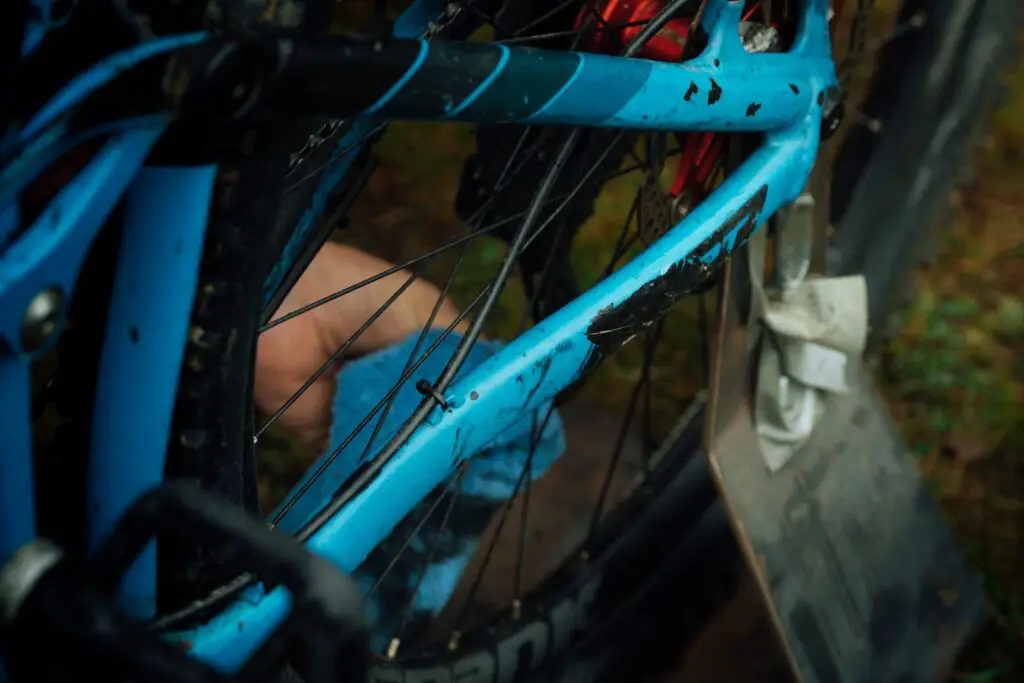Maintaining a bicycle’s tires is essential to ensuring its proper functioning. A slowly deflating tire can be irritating and impede the performance of the bike, leading to potential safety risks. The following tips will help to fix a slowly deflating bike tire in mere minutes.
The process begins by first locating the source of the leak. It is important to note that there are two types of punctures that can cause a slow deflation: those caused by objects embedded in the tire and those caused by air leaking from within the tube itself due to an old valve or faulty patch job. Once the source has been identified, appropriate measures must be taken to resolve it.

To fix an object-caused puncture, one must remove the object and patch up any holes in both the tube and tire with a repair kit before re-inflating it. To fix an air-leaking puncture, replace any worn out valves or faulty patches with new ones before re-inflating the tube. With these simple steps, bicycle maintenance experts will have their bike’s tires back up and running in no time!
Preparing The Bike
Preparation is the key to successful bike repair. Ensuring the bike is properly prepared for tire repair can save time, money and effort in the long run. Consequently, it is essential to ensure the bike is ready for fixing the tire before any work commences.
The first step to prepare a bike for repair is to ascertain what type of tire needs replacing. Clincher tires are standard on most bikes, however tubular tires may be more appropriate depending on terrain and usage. This will also help determine what type of patch kit might be necessary. Assuming a clincher tire, it should then be removed from the rim before any further work can begin. Careful removal ensures no damage is caused during this process, allowing for an efficient repair afterwards.
Having removed the tire, checking both the inside and outside of the tube should take place in order to identify any potential punctures or holes that may have been present prior to deflating. It’s also important to check inside the wheel rim for any objects such as glass shards or metal splinters which could have caused puncture damage. After inspection has been completed, preparations are complete and repairs can begin.
Locating The Puncture
Locating the puncture in a slowly deflating bike tire is a crucial step in fixing the tire. To pinpoint the puncture, it is best to start by examining the exterior of the tire for any signs of protruding objects that may have caused the puncture. If an object is visible on the surface of the tire, it needs to be removed before proceeding further.
Once any visible signs of object punctures have been removed from the exterior, it is time to inspect the inside of the tire more closely. Checking for air bubbles along the inner walls of the tube is an effective way to spot a puncture. It can also be helpful to lightly press on different sections of both sides of the tire with your fingers and look for any weak spots that are releasing air at a faster rate than other areas.
Using these techniques will help you identify and locate where a puncture has occurred in your bicycle’s tire so that you can move on to repairing it.
Removing The Tire
When fixing a slowly deflating bike tire, the first step is to remove the tire from the wheel. This can be done with a few simple tools. First, use a tire lever to remove the bead of the tire from the rim of the wheel. The second tool needed is an adjustable wrench to loosen and remove any bolts that may be holding the wheel in place.
Once these tools have been used, it will be possible to take out both sides of the inner tube from within the tire. Here are some tips for successful tire removal:
- Ensure that all air has been completely released from the inner tube before attempting to remove it
- Carefully pull out each side of the inner tube so that no damage is done to it
- Use your fingers to locate any punctures or tears in order to make sure you can properly repair them during bike repair
- Remove any debris or contaminants that could cause further damage while handling and repairing your bike tires.
After successfully removing both sides of the inner tube, replace it with a new one and reinstall your tire back onto your bike. Make sure all bolts are securely tightened before taking your bike back on its next ride!
Repairing The Tire
According to a survey of cyclists, nearly 45% of riders have experienced a flat tire on the road. Repairing a slowly deflating bike tire can be done in minutes with the right tools and techniques.
First, it is important to find the puncture and determine the cause. Inspect both sides of the tire for cuts, abrasions, or embedded objects. If necessary, use a bright flashlight to help identify the source of the leak. Once the puncture is located, gently remove any foreign material and clean up the area around it.
Next, prepare to patch or replace the tube depending on its condition. If there are several small holes, patching may be an option using a rubber patch kit and vulcanizing glue. However, if there is a large tear in the tube or multiple punctures in one area, then it may be best to replace it entirely with a new tube that matches your wheel size and tire type.
Finally, once all repairs are complete, inflate your tire following instructions from your pump’s user manual and check for leaks periodically over time to ensure proper maintenance of your bicycle tires. Taking these steps will help ensure that you can ride safely again with minimal delays due to flat tires in the future.
Finishing Up
Once the tire is properly inflated, the bicycle maintenance expert reattaches it to the wheel.
First, the nut that holds the tire to the wheel is checked for tightness. If necessary, it can be tightened with a wrench.
After that, the wheel should be given another spin to ensure that it turns freely and without any wobbling.
Lastly, any remaining air should be let out of the tire using an inflator or other device. The pressure should then be checked one last time before putting everything back together and ensuring that all nuts and bolts are tight. A properly inflated and reattached tire will provide a smooth ride for miles to come.
| Step | Description | Tool Needed |
|---|---|---|
| 1 | Reattach Tire to Wheel | Wrench |
| 2 | Check Tightness of Nut Holding Tire on Wheel | Wrench/Spanner |
| 3 | Spin Wheel To Ensure Balance & Smoothness | None |
| 4 | Let Out Any Remaining Air with Inflator or Device | Inflator or Device |
| 5 | Check Pressure Once More Before Putting Everything Back Together | None |
Conclusion
Biking is a great way to get around, reduce emissions and get some exercise at the same time. The last thing you want is for your tire to deflate suddenly, but with the right knowledge and equipment, you can fix it quickly and easily. The steps outlined in this article provide an easy-to-follow guide for repairing a slowly deflating bike tire in minutes. By following these steps, you’ll be able to get back on your bike and enjoy the ride without worrying about a flat tire.
The process of fixing a deflated bike tire can be seen as a metaphor for taking control of one’s own life: locating the puncture is key to finding the source of the problem, while removing and replacing the tire symbolizes putting in the effort needed to make progress. Finally, finishing up means trusting that all efforts have been put into place to ensure success.
In this sense, fixing a slowly deflating bike tire is more than just a practical task; it’s also an opportunity to practice self-management skills. With patience and perseverance, even a slow leak can be fixed in minutes!
